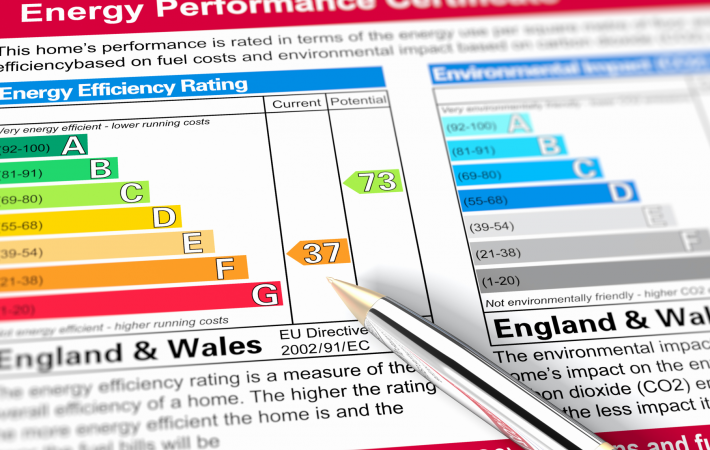30 August 2023
Old properties, new problems: why energy efficiency rules will be a major cost for landlords


The UK has the oldest housing stock in Europe and a property’s age is the single biggest factor in determining its energy efficiency.
34% of homes across the UK were built before 1945 and 20% before 1919, and while our heritage should rightly be celebrated, this does present serious problems for property owners, particularly those with a portfolio of rented properties.
As well as the cost of heating and maintaining an older property, new standards for energy efficiency mean some landlords may have to spend up to £10,000 upgrading their older houses.

An Energy Performance Certificate (EPC) gives a property an energy efficiency rating from A (most efficient) to G (least efficient) and is valid for 10 years. It has been a legal requirement since 2008 for properties which are either marketed or let to have an EPC.
In 2018, the Minimum Energy Efficiency Standards (MEES) came into force and these rules made it unlawful for a landlord to grant a new tenancy or to extend or renew an existing tenancy of certain property having an EPC rating of F or G.
As of 1st April 2023, it is also unlawful for a landlord to continue to let a commercial premises with an EPC rating of F or G (that is even if the lease was granted prior to the MEES Regulations coming into force in 2018).
Now, the Government has proposed that from April 2025, all new lets would need a minimum EPC rating of C and all other existing tenancies would need to comply by 2028.
This has already undergone government consultation and confirmation of the proposals are expected later in the year.
If the jump in energy efficiency rating from ‘E’ to ‘C’ isn’t enough, the penalty for not having a valid EPC would also be raised from £5,000 to £30,000 from 2025.
It is well documented that the Government hopes to make homes more energy-efficient and reduce carbon emissions as part of its plans to be net-zero by 2050.
While this goal is broadly popular, this policy is a controversial move because 64% of rental properties in England and Wales have an EPC rating of D or below – that’s 2.26 million homes. Yorkshire and the Humber has the highest proportion with 69%, according to Ministry of Housing data (now known as the Department for Levelling Up, Housing and Communities).
Achieving an EPC rating of ‘C’ will be difficult, particularly for older properties, but not impossible.
Fortunately, there is a cost cap which limits the amount landlords can be expected to pay to improve the energy efficiency of their properties. Currently, this is capped at £3,500 but it has been proposed that this will rise to £10,000 from April 2025.
The government estimates that the improvements needed to reach an EPC rating of ‘C’ will cost landlords around £4,700 for most properties but this is dependent on a number of variables including the location of your property and access to materials.
As for the work itself, the government is encouraging a “fabric first” approach, covering wall, loft and floor insulation. It is also recommended that landlord’s install smart meters at their properties.
Landlords of older properties may be daunted by the prospect of spending up to £10,000 on each house in their portfolio, but not every property will require an EPC. It is also important to bear in mind that these are only proposals that are yet to be set in stone.
While the vast majority of properties would be covered by the rules, you do not need an EPC if you can demonstrate that the building is:
Listed or officially protected and the minimum energy performance requirements would unacceptably alter it
A temporary building only going to be used for two years or less
Used as a place of worship or for other religious activities
An industrial site, workshop, or non-residential agricultural building that doesn’t use much energy
A detached building with a total floor space under 50 square metres
Due to be demolished by the seller or landlord and they have all the relevant planning and conservation consents
The new regime would also apply to lease assignments and sub-lettings. In this situation, it will be the tenant that would need to provide an EPC so they may wish to obtain a copy of the building's EPC, or commission their own where one is not already available.
Where this is the case, the landlord may wish to include lease wording which states that the landlord will be provided with a copy of the EPC, so that they have the most up to date certificate for the building.

It is important to bear in mind that these proposals are, at the time of writing, just that; proposals. It is thought that the government may ultimately end up pushing back the dates in order to allow landlords more time to prepare for the new regime. However, landlords and tenants should ensure they are informed about the proposed changes to the rules and that they plan for these.
To receive an EPC, you must have an Energy Assessment Survey carried out at your property. To get a new energy certificate, you must arrange for an accredited energy assessor to visit your property.
If you’re a landlord owning properties that may fall below a C rating, contact our commercial property team for professional advice and guidance to ensure you remain compliant with the new rules.

Contact Amy to discuss this further.